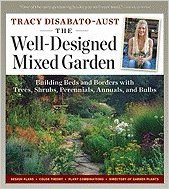 Designing a garden is one of the most creative aspects of gardening but can also be one of the most difficult. Tracy DiSabato-Aust’s book, The Well-Designed Mixed Garden, provides the information needed to create a beautiful garden with year-round interest using a wide variety of plant material, from annuals, to perennials, shrubs and trees. Touching on all the important aspects of garden design, the author includes theory as well as facts with an abundance of supplementary material to make the garden design process fun as well as satisfying.
Designing a garden is one of the most creative aspects of gardening but can also be one of the most difficult. Tracy DiSabato-Aust’s book, The Well-Designed Mixed Garden, provides the information needed to create a beautiful garden with year-round interest using a wide variety of plant material, from annuals, to perennials, shrubs and trees. Touching on all the important aspects of garden design, the author includes theory as well as facts with an abundance of supplementary material to make the garden design process fun as well as satisfying.
After a discussion of basic considerations of garden design from site evaluation to plant selection, the author plunges into a detailed examination on color theory and the importance of form and texture in garden design. Especially interesting are the sections on factors affecting color perception and the use of color to create a mood and aura. Other chapters deal with basic design principles, drawing the design to scale, inclusion of garden ornaments, and maintenance issues. Two extensive chapters are devoted to specific design plans for small, medium, and large gardens, with extensive plant lists and watercolor enhanced diagrams.
A unique part of the book features plant combinations. For each of twenty seven plant combinations the author provides an analysis of how the combination works, the care required to keep it looking attractive, and descriptive information on each plant. All of the design principles presented in the first part of the book are integrated in this section so that the reader can see their application in actual garden settings.
Three appendices take up almost two hundred pages and contain a wealth of important information. The first is a list of plants by Latin name giving the common name for each. The second contains a chart listing plants by design characteristics and includes a brief description, bloom time, hardiness zones, form, size, color, and texture. This is followed by lists of flowers by color and bloom time as well as by theme (i.e. fragrance, butterflies, hummingbirds). The third appendix includes a chart showing cultural considerations such as soil moisture and light, and a list of plants for specific conditions, such as dry shade.
The author has a very entertaining upbeat style of writing that makes reading a personal adventure. The plant combinations section is extremely helpful in understanding the theoretical material presented in the first part of the book and the appendices greatly facilitate the application of the material to the design process. The text is illustrated with numerous photographs of the author’s Ohio garden and other gardens in her area and are adequate but not outstanding. This books is lively reading but the meat is in the plant combinations and appendices B and C.